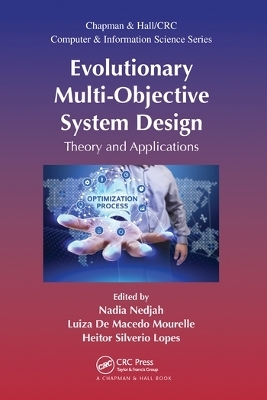
Evolutionary Multi-Objective System Design
Theory and Applications
Seiten
2020
Chapman & Hall/CRC (Verlag)
978-0-367-57280-8 (ISBN)
Chapman & Hall/CRC (Verlag)
978-0-367-57280-8 (ISBN)
Evolutionary multi-objective optimization (EMO) has emerged as a sub-discipline of multi-objective optimization, combining the fields of evolutionary computation and classical multiple criteria decision making. This field has applications in artificial intelligence, machine learning, and data mining. This book will present new trends, methods, a
Real-world engineering problems often require concurrent optimization of several design objectives, which are conflicting in cases. This type of optimization is generally called multi-objective or multi-criterion optimization. The area of research that applies evolutionary methodologies to multi-objective optimization is of special and growing interest. It brings a viable computational solution to many real-world problems.
Generally, multi-objective engineering problems do not have a straightforward optimal design. These kinds of problems usually inspire several solutions of equal efficiency, which achieve different trade-offs. Decision makers’ preferences are normally used to select the most adequate design. Such preferences may be dictated before or after the optimization takes place. They may also be introduced interactively at different levels of the optimization process. Multi-objective optimization methods can be subdivided into classical and evolutionary. The classical methods usually aim at a single solution while the evolutionary methods provide a whole set of so-called Pareto-optimal solutions.
Evolutionary Multi-Objective System Design: Theory and Applications
provides a representation of the state-of-the-art in evolutionary multi-objective optimization research area and related new trends. It reports many innovative designs yielded by the application of such optimization methods. It also presents the application of multi-objective optimization to the following problems:
Embrittlement of stainless steel coated electrodes
Learning fuzzy rules from imbalanced datasets
Combining multi-objective evolutionary algorithms with collective intelligence
Fuzzy gain scheduling control
Smart placement of roadside units in vehicular networks
Combining multi-objective evolutionary algorithms with quasi-simplex local search
Design of robust substitution boxes
Protein structure prediction problem
Core assignment for efficient network-on-chip-based system design
Real-world engineering problems often require concurrent optimization of several design objectives, which are conflicting in cases. This type of optimization is generally called multi-objective or multi-criterion optimization. The area of research that applies evolutionary methodologies to multi-objective optimization is of special and growing interest. It brings a viable computational solution to many real-world problems.
Generally, multi-objective engineering problems do not have a straightforward optimal design. These kinds of problems usually inspire several solutions of equal efficiency, which achieve different trade-offs. Decision makers’ preferences are normally used to select the most adequate design. Such preferences may be dictated before or after the optimization takes place. They may also be introduced interactively at different levels of the optimization process. Multi-objective optimization methods can be subdivided into classical and evolutionary. The classical methods usually aim at a single solution while the evolutionary methods provide a whole set of so-called Pareto-optimal solutions.
Evolutionary Multi-Objective System Design: Theory and Applications
provides a representation of the state-of-the-art in evolutionary multi-objective optimization research area and related new trends. It reports many innovative designs yielded by the application of such optimization methods. It also presents the application of multi-objective optimization to the following problems:
Embrittlement of stainless steel coated electrodes
Learning fuzzy rules from imbalanced datasets
Combining multi-objective evolutionary algorithms with collective intelligence
Fuzzy gain scheduling control
Smart placement of roadside units in vehicular networks
Combining multi-objective evolutionary algorithms with quasi-simplex local search
Design of robust substitution boxes
Protein structure prediction problem
Core assignment for efficient network-on-chip-based system design
Nadia Nedjah, Luiza De Macedo Mourelle, Heitor Silverio Lopes
Embrittlement of Stainless Steel Coated Electrodes. Learning Fuzzy Rules from Imbalanced Datasets using Multi-objective Evolutionary Algorithms. Hybrid Multi-Objective Evolutionary Algorithms with Collective Intelligence. Multiobjective Particle Swarm Optimization Fuzzy Gain Scheduling Control. Multiobjective evolutionary algorithms for smart placement. Solving Multi-Objective Problems with MOEA/D and Quasi-Simplex Local Search. Multi-objective Evolutionary Design of Robust Substitution Boxes. Multi-objective approach to the Protein Structure Prediction Problem. Multi-objective IP Assignment for Efficient NoC-based System Design.
| Erscheinungsdatum | 01.07.2020 |
|---|---|
| Reihe/Serie | Chapman & Hall/CRC Computer and Information Science Series |
| Sprache | englisch |
| Maße | 156 x 234 mm |
| Gewicht | 453 g |
| Themenwelt | Technik ► Elektrotechnik / Energietechnik |
| ISBN-10 | 0-367-57280-X / 036757280X |
| ISBN-13 | 978-0-367-57280-8 / 9780367572808 |
| Zustand | Neuware |
| Informationen gemäß Produktsicherheitsverordnung (GPSR) | |
| Haben Sie eine Frage zum Produkt? |
Mehr entdecken
aus dem Bereich
aus dem Bereich
Technologie – Berechnung – Klimaschutz
Buch | Hardcover (2023)
Hanser (Verlag)
39,99 €


